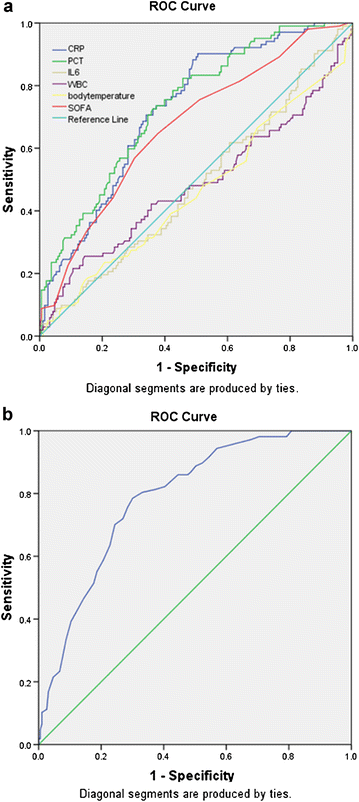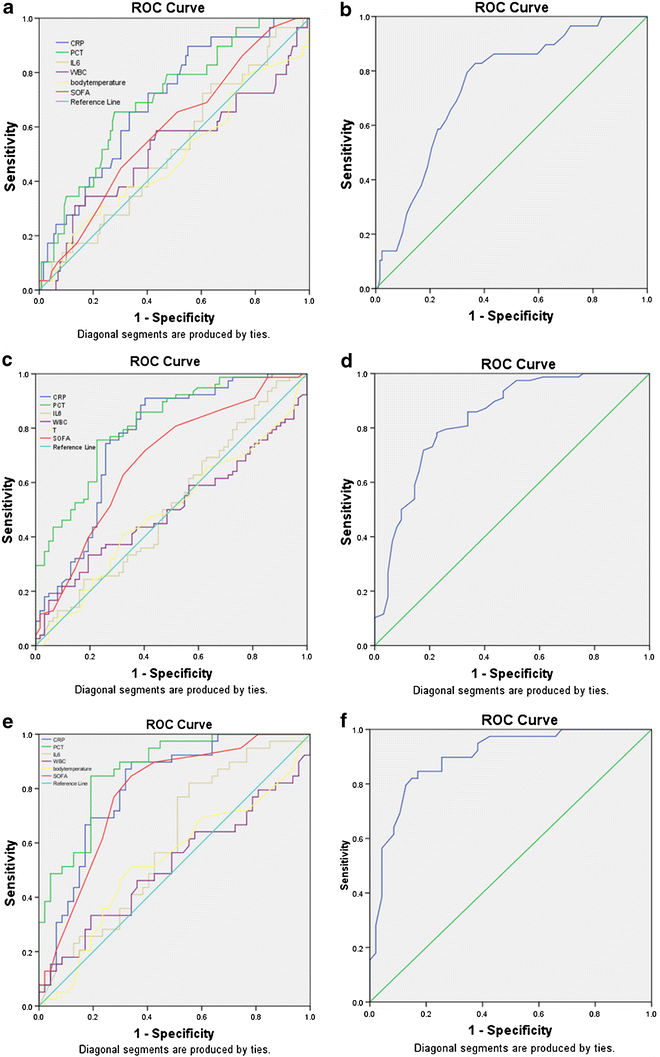Combination of C-reactive protein, procalcitonin and sepsis-related organ failure score for the diagnosis of sepsis in critical patients
- PMID: 27287669
- PMCID: PMC4901212
- DOI: 10.1186/s13613-016-0153-5
Combination of C-reactive protein, procalcitonin and sepsis-related organ failure score for the diagnosis of sepsis in critical patients
Abstract
Objective: To measure the ability of a new bioscore to diagnose sepsis in a general critical care population.
Methods: The study was done at an intensive care unit (ICU) from April to December 2012. Demographic and clinical patient information were recorded on admission to the ICU with blood samples taken for C-reactive protein (CRP), procalcitonin (PCT), interleukin-6, white blood cell count, as well as body temperature, age and the sepsis-related organ failure (SOFA) score. These parameters were used to create a scoring system. The scoring system then underwent analysis by univariate analysis and multivariate logistic regression analysis to identify which of these clinical parameters were statistically different in septic versus non-septic patients. The bioscore was then tested in a receiver operator characteristic curve to determine statistical significance of the scoring systems ability to predict sepsis. Finally, a bioscore cutoff value was defined to provide a level for sepsis diagnosis.
Results: Three hundred patients were enrolled, of which 107 patients were septic and 193 patients were non-septic. Univariate logistic regression showed that age, gender, CRP, PCT and SOFA were risk factors for occurrence of sepsis. Multivariate analysis revealed CRP (AUC 0.729, 95 % CI 0.671-0.787, P < 0.001), PCT (AUC 0.711, 95 % CI 0.652-0.770, P < 0.001) and SOFA (AUC 0.670, 95 % CI 0.607-0.733, P < 0.001) to be statistically significant. The combination of these values in the bioscore had an AUC of 0.790 (95 % CI 0.739-0.834, P < 0.001). A bioscore of ≥2.65 was considered to be statistically significant in making a positive diagnosis of sepsis.
Conclusions: This bioscore using CRP, PCT and SOFA score may potentially be used in the future to help identify septic patients earlier, improving their access to timely treatment modalities.
Keywords: Bioscore; C-reactive protein; Interleukin-6; Procalcitonin; Sepsis.
Figures


References
-
- Garnacho-Montero J, Ortiz-Leyba C, Herrera-Melero I, Aldabo-Pallas T, Cayuela-Dominguez A, Marquez-Vacaro JA, Carbajal-Guerrero J, Garcia-Garmendia JL. Mortality and morbidity attributable to inadequate empirical antimicrobial therapy in patients admitted to the ICU with sepsis: a matched cohort study. J Antimicrob Chemother. 2008;61:436–441. doi: 10.1093/jac/dkm460. - DOI - PubMed
LinkOut - more resources
Full Text Sources
Other Literature Sources
Research Materials
Miscellaneous

